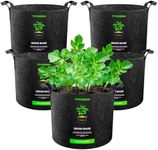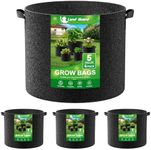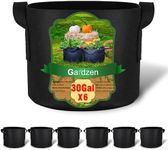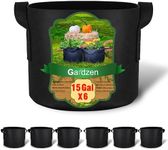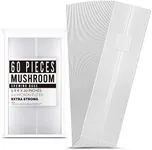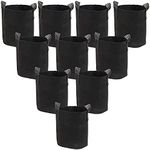Buying Guide for the Best Grow Bags
Choosing the right grow bags for your gardening needs can significantly impact the health and growth of your plants. Grow bags are a versatile and convenient option for both indoor and outdoor gardening. They offer excellent drainage, aeration, and root health, making them a popular choice among gardeners. When selecting grow bags, it's important to consider several key specifications to ensure you pick the best fit for your plants and gardening setup.MaterialThe material of the grow bag is crucial as it affects durability, breathability, and water retention. Common materials include fabric, plastic, and biodegradable options. Fabric grow bags are popular because they provide excellent aeration and drainage, preventing root rot and promoting healthy root systems. Plastic grow bags are more durable and retain moisture better, making them suitable for plants that require consistent watering. Biodegradable grow bags are eco-friendly and can be planted directly into the ground, decomposing over time. Choose the material based on your plant's needs and your environmental preferences.
SizeGrow bags come in various sizes, typically measured in gallons or liters. The size you choose should correspond to the type of plant you intend to grow. Smaller bags (1-3 gallons) are ideal for herbs, small flowers, and seedlings. Medium-sized bags (5-10 gallons) are suitable for vegetables like peppers, tomatoes, and small shrubs. Larger bags (15 gallons and above) are best for larger plants, such as potatoes, fruit trees, and large shrubs. Consider the mature size of your plant and its root system when selecting the size of the grow bag.
DrainageProper drainage is essential to prevent waterlogging and root rot. Most grow bags are designed with good drainage in mind, but it's important to check for features like drainage holes or breathable fabric. Fabric grow bags naturally provide excellent drainage, while plastic bags may need additional holes. Ensure that the grow bag you choose allows excess water to escape easily, keeping the soil well-aerated and preventing water-related issues.
HandlesHandles on grow bags can make them much easier to move, especially when they are filled with soil and plants. This is particularly useful for indoor gardening or if you need to relocate your plants to different areas for optimal sunlight or protection from harsh weather. Look for sturdy, reinforced handles that can support the weight of the filled grow bag without tearing.
UV ResistanceUV resistance is an important feature for grow bags that will be used outdoors. UV-resistant grow bags are treated to withstand prolonged exposure to sunlight without degrading. This ensures that the bags remain durable and functional over multiple growing seasons. If you plan to use your grow bags outside, especially in sunny areas, opt for UV-resistant options to extend their lifespan.
ReusabilityReusability is a key factor for gardeners looking for sustainable and cost-effective options. High-quality grow bags can be reused for several growing seasons, reducing waste and saving money. Look for grow bags made from durable materials that can withstand repeated use and washing. Reusable grow bags are a great investment for long-term gardening projects.


